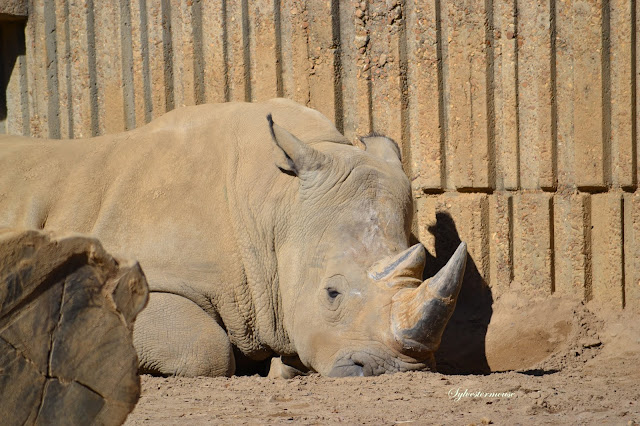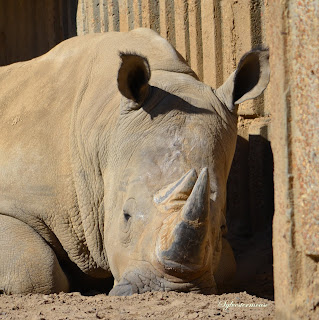In the late 19th century, Southern White Rhinos were thought to be extinct. However, a small herd was found in 1895 and they have been protected ever since. Statistics now indicate that there are over 20,000 living Southern White Rhinos and they are the only rhinos that are not endangered at this time. Unfortunately, that makes them a target for poachers and the illegal trade of their horns, which are consumed by the wealthy as a symbol of their elite status.
I couldn't help but think what a gentle giant this sweet Southern White Rhino was when I was photographing her. She has such a serene look on her face. She might not normally be the kind of animal that we would find endearing, but this one was. I only had to stop long enough to really look and pay attention to her. Oh, and if you look closely at the introduction picture, you can see the hair fringing her ears.
 |
| Photo by Cynthia Sylvestermouse |
Facts About the Southern White Rhino
 |
| Left Image Attribution: By TomFawls [CC BY-SA 3.0 (https://creativecommons.org/licenses/by-sa/3.0)], from Wikimedia Commons Right Image Attribution: By Ltshears [CC BY-SA 3.0 (https://creativecommons.org/licenses/by-sa/3.0)], from Wikimedia Commons |
The Southern White Rhino (image on the left) has a square muzzle instead of the pointed upper lip of the black rhino (image on the right).
- Life Span (wild): 30 yrs
- Life Span (captivity): 40 yrs
- Weight: Up to 5000 pounds
- Diet: Grass & Leaves
- Almost No Hair
- Most Hair found on tail & ears
- Two Horns
- Front Horn Length - Up to 60" (average 24")
- Regions: South Africa, Zimbabwe, Kenya and Namibia
- Near Threatened (previously endangered)
Wild Republic White Rhino Plush, Stuffed Animal, Plush Toy, Gifts for Kids, Cuddlekins 12"Check PriceThe Great Rhino Rescue the Great Rhino Rescue: Saving the Southern White Rhinos Saving the Southern White Rhinos (Sandra Markle's Science Discoveries)Check Price
Note: The author may receive a commission from purchases made using links found in this article. “As an Amazon Associate I earn from qualifying purchases.”



No comments:
Post a Comment